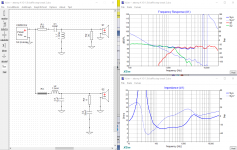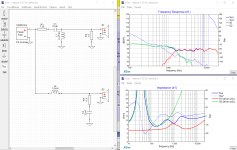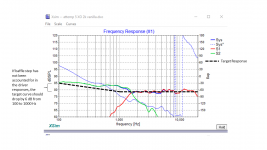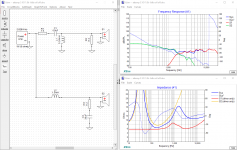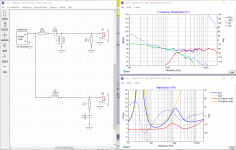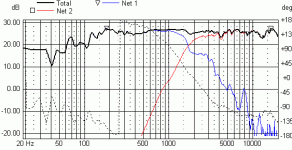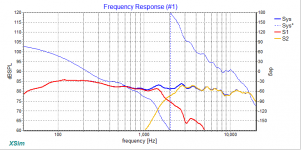Hi,
I'd really appreciate some feedback on my first time cross over sim before I go ahead and buy the parts?
I have no measurement equipment and I'm aiming to just get a decent first time build crossover, not aiming for a perfect studio monitor.
I've read "intro to crossovers without measurement equipment" did my calculation and hopped into Xsim to cook something up for these Dayton components. I've made multiple sims but this is the one I thought looked the best.
The values I'm using are the manufacture's 2 pi infinite baffle specs, I don't have excel or the response modeler add on (referenced in Paul Carmody's "designing a speaker with simulated measurements") to sim FRDs and ZMAs when in a cabinet. Hoping this data is accurate enough to get a good first time build done.
I've tried to compensate for baffle step by creating a dip after 1k, I didn't go for the full -6db as it just looked a bit severe in the mid range. Thoughts on that?
I'm a little worried about the impedance values, do you think this will damage a 4-8ohm amp? Or will it be fine?
Tweeter fs = 834, I am I risking distortion/damage crossing over this low?
I know human hearing is more sensitive to mid f, should I compensate for this?
There is a small peak around 5.5K, do you think this will become fatiguing?
Finally, ignore the series resistor on the woofer. Was just an experiment but I've shorted it so it'll have no effect.
If you've made it to the end of the post thank you! I'd really love to know hat you guys think 🙂
Woofer:Dayton Audio DC160-8 6-1/2" Classic Woofer
Tweeter:Dayton Audio DC160-8 6-1/2" Classic Woofer
Luke.
I'd really appreciate some feedback on my first time cross over sim before I go ahead and buy the parts?
I have no measurement equipment and I'm aiming to just get a decent first time build crossover, not aiming for a perfect studio monitor.
I've read "intro to crossovers without measurement equipment" did my calculation and hopped into Xsim to cook something up for these Dayton components. I've made multiple sims but this is the one I thought looked the best.
The values I'm using are the manufacture's 2 pi infinite baffle specs, I don't have excel or the response modeler add on (referenced in Paul Carmody's "designing a speaker with simulated measurements") to sim FRDs and ZMAs when in a cabinet. Hoping this data is accurate enough to get a good first time build done.
I've tried to compensate for baffle step by creating a dip after 1k, I didn't go for the full -6db as it just looked a bit severe in the mid range. Thoughts on that?
I'm a little worried about the impedance values, do you think this will damage a 4-8ohm amp? Or will it be fine?
Tweeter fs = 834, I am I risking distortion/damage crossing over this low?
I know human hearing is more sensitive to mid f, should I compensate for this?
There is a small peak around 5.5K, do you think this will become fatiguing?
Finally, ignore the series resistor on the woofer. Was just an experiment but I've shorted it so it'll have no effect.
If you've made it to the end of the post thank you! I'd really love to know hat you guys think 🙂
Woofer:Dayton Audio DC160-8 6-1/2" Classic Woofer
Tweeter:Dayton Audio DC160-8 6-1/2" Classic Woofer
Luke.
Attachments
If you place the speakers closer to the wall, or plan to, then you don't need the baffle step compensation. Otherwise, it does not look like you applied enough. You tend to drop 3-5 dB from spec when it is applied. Your speaker is showing 85 dB, which means almost none was applied.
The area I'm a little worried about is the 2nd order components which go to ground (L1/C3) make sure you have the correct DCR or ESR as appropriate or they'll play havoc with your impedance. You can use REW with a simple jig to measure this, as well as the impedance of the drivers and entire speaker. Highly recommended.
The area I'm a little worried about is the 2nd order components which go to ground (L1/C3) make sure you have the correct DCR or ESR as appropriate or they'll play havoc with your impedance. You can use REW with a simple jig to measure this, as well as the impedance of the drivers and entire speaker. Highly recommended.
I've tried to compensate for baffle step by creating a dip after 1k, I didn't go for the full -6db as it just looked a bit severe in the mid range. Thoughts on that?
Since you are using the OEM infinite baffle response for design, you do need to compensate for baffle step. You have done a little, but I think you need more. You should aim for a response that drops gradually by 6 dB from 100 Hz to 1000 Hz. Without doing detailed measurements, this is close enough for good sound. Try increasing L2.
Tweeter fs = 834, I am I risking distortion/damage crossing over this low?
I think you should be aiming for a 2 kHz crossover.
What tweeter are you using, please - both links are to the Dayton DC160 Classic woofer.
If you're using the Dayton DC28F there's already a good XO for that combination b Dennis Murphy at Murphyblaster.com. More parts than your design, crossover point about 1800Hz.
Not trying to dissuade you from doing your own thing, but Dennis' work is highly regarded and that speaker was very well reviewed.
HTH
Geoff
If you're using the Dayton DC28F there's already a good XO for that combination b Dennis Murphy at Murphyblaster.com. More parts than your design, crossover point about 1800Hz.
Not trying to dissuade you from doing your own thing, but Dennis' work is highly regarded and that speaker was very well reviewed.
HTH
Geoff
PS to above post: the DC160 is a good, budget woofer which gives great bass in the right cabinet: I've used it in Paul Carmody's "Classix II", very pleased with the sound. It's a bit laid back in the mid-range but that's fine for long listening sessions. As discussed by Paul in his write up, the Classix cope really well with less well recorded and mixed music.
It's not for large rooms as it will 'bottom out' on bass heavy recordings if you push the volume too much. I think the XO for the Classix II is about 2,000Hz.
Geoff
It's not for large rooms as it will 'bottom out' on bass heavy recordings if you push the volume too much. I think the XO for the Classix II is about 2,000Hz.
Geoff
What tweeter are you using, please - both links are to the Dayton DC160 Classic woofer.
If you're using the Dayton DC28F there's already a good XO for that combination b Dennis Murphy at Murphyblaster.com. More parts than your design, crossover point about 1800Hz.
Not trying to dissuade you from doing your own thing, but Dennis' work is highly regarded and that speaker was very well reviewed.
HTH
Geoff
OOPS
Tweeters:
Dayton Audio DC28F-8 1-1/8" Silk Dome Tweeter
Thank you every one for your feedback! I hear you:
I've added better baffle step compensation (-5dB)
Removed part coursing problematic impedance
Moved XO point to 2000k
Afew more questions for you, if you have the time:
Will this impedance be problematic still?
Some extra context: I'm using this setup for a portable outdoor speaker with a wide front baffle (brief case design).
Will the wide baffle (30cm widest distance) reflect longer wave lengths thus making point at which baffle step effects audio lower in frequency?
Slight side note but just checking my understanding of baffle diffraction, please correct my if I'm wrong: Will the wide baffle also increase diffraction of long wavelengths causing potential dead spots at lower frequencies than normal?
I've added better baffle step compensation (-5dB)
Removed part coursing problematic impedance
Moved XO point to 2000k
Afew more questions for you, if you have the time:
Will this impedance be problematic still?
Some extra context: I'm using this setup for a portable outdoor speaker with a wide front baffle (brief case design).
Will the wide baffle (30cm widest distance) reflect longer wave lengths thus making point at which baffle step effects audio lower in frequency?
Slight side note but just checking my understanding of baffle diffraction, please correct my if I'm wrong: Will the wide baffle also increase diffraction of long wavelengths causing potential dead spots at lower frequencies than normal?
Attachments
What tweeter are you using, please - both links are to the Dayton DC160 Classic woofer.
If you're using the Dayton DC28F there's already a good XO for that combination b Dennis Murphy at Murphyblaster.com. More parts than your design, crossover point about 1800Hz.
Not trying to dissuade you from doing your own thing, but Dennis' work is highly regarded and that speaker was very well reviewed.
HTH
Geoff
Thank you, brilliant! I'll look that up and take notes
Actually I like your post#1 crossover better than your post#7. The first response might be a little light in the bass, but it would have a smooth midrange. Your second response is going to have too much energy in the 500-1500 Hz region.
In theory, baffle width and height affect baffle step, and yes a 30 cm wide baffle will transition from 4 pi to 2 pi a little lower than a 22 cm wide baffle. But in practice, the distance to the floor and the back wall have an effect. Compensating for baffle step is always an approximation. Because you are designing without measurements, I recommend a "middle of the road" approach.
I have copied your graphic and added the target response you should be shooting for.
It does not look like it changed much.Moved XO point to 2000k
Will the wide baffle (30cm widest distance) reflect longer wave lengths thus making point at which baffle step effects audio lower in frequency?
In theory, baffle width and height affect baffle step, and yes a 30 cm wide baffle will transition from 4 pi to 2 pi a little lower than a 22 cm wide baffle. But in practice, the distance to the floor and the back wall have an effect. Compensating for baffle step is always an approximation. Because you are designing without measurements, I recommend a "middle of the road" approach.
I have copied your graphic and added the target response you should be shooting for.
Attachments
If you're interested in going that route, Mr Murphy's speakers were called the "Affordable Accuracy Monitors", there are several reviews on the web. As per his website, Dennis used the Parts Express Dayton BR-1 kit as his starting point and re-designed the crossover for better sound. PE's product page has a good discussion of how the BR-1 crossover was designed, including how to calculate the Zobel network.Thank you, brilliant! I'll look that up and take notes
I was going to build a pair as I had some spare DC160s but only one tweeter, but the DC28 shot up in price and I didn't proceed. The Affordable Accuracy Monitors now use a Morel tweeter.
Geoff
Actually I like your post#1 crossover better than your post#7. The first response might be a little light in the bass, but it would have a smooth midrange. Your second response is going to have too much energy in the 500-1500 Hz region.
It does not look like it changed much.
In theory, baffle width and height affect baffle step, and yes a 30 cm wide baffle will transition from 4 pi to 2 pi a little lower than a 22 cm wide baffle. But in practice, the distance to the floor and the back wall have an effect. Compensating for baffle step is always an approximation. Because you are designing without measurements, I recommend a "middle of the road" approach.
I have copied your graphic and added the target response you should be shooting for.
Thanks again, here's what I've come up with based on your feedback:
Changed the XO point (properly this time).
Added 100-1K roll off.
What do think of the 1.6K - 5K region, its a bit lack luster but not sure I can get around that?
These impedance values are scaring me, mainly because I'm not sure how to tell when they are and when they are not safe. Any pointers?
If the impedance is problematic, how do I fix that?
Haven't yet done my research on proven crossovers yet but I plan to do that today. Might have a different design based on those by the end of the day.
Again really appreciate the input, forum feedback is the closest thing I can get to going to university and studying this stuff , if there is a course for it that is 😀
Attachments
Your impedance looks fine to me. It drops to a minimum of 6.5 ohm at 200 Hz... well within the capabilities of any amp.
I think your tweeter level is depressed by a few dB. Try reducing R1 in small increments, until you get the tweeter level at 6 kHz to match the woofer level at 800 - 1000 Hz. R1 is called an "Amp-side" resistor, and small changes in Amp-side resistors do not affect the overall crossover characteristics.
You are getting close... nice work!
j.
I think your tweeter level is depressed by a few dB. Try reducing R1 in small increments, until you get the tweeter level at 6 kHz to match the woofer level at 800 - 1000 Hz. R1 is called an "Amp-side" resistor, and small changes in Amp-side resistors do not affect the overall crossover characteristics.
You are getting close... nice work!
j.
If you're interested in going that route, Mr Murphy's speakers were called the "Affordable Accuracy Monitors", there are several reviews on the web. As per his website, Dennis used the Parts Express Dayton BR-1 kit as his starting point and re-designed the crossover for better sound. PE's product page has a good discussion of how the BR-1 crossover was designed, including how to calculate the Zobel network.
I was going to build a pair as I had some spare DC160s but only one tweeter, but the DC28 shot up in price and I didn't proceed. The Affordable Accuracy Monitors now use a Morel tweeter.
Geoff
Hi, thanks again.
I found the schematic on Murphyblaster and plugged all the values into xsim but they look like total trash. Have I got something wrong or is it because I'm using FRD data from the DC28F and not the Morel?
Please could you link me to Morel you are talking about, I cant seem to find it on parts express? Thanks
Your post#13 filter looks good to go. Nicely done. This is about as good as you need to be with a design based on OEM curves.
When you order your crossover parts, be sure to get a collection of resistors for trimming the value of R1 by ear. For example, instead of a single 6 ohm, get a 3.9 ohm and four 1 ohm's.
When you order your crossover parts, be sure to get a collection of resistors for trimming the value of R1 by ear. For example, instead of a single 6 ohm, get a 3.9 ohm and four 1 ohm's.
Hi, thanks again.
Please could you link me to Morel you are talking about, I cant seem to find it on parts express? Thanks
Apologies, it's called the Affordable Accuracy Monitor Plus:
The New Affordable Accuracy Plus Monitor
It uses the Morel MDT32S: Morel MDT32S 1" Textile Dome Tweeter, Aluminum Face Plate, Rear chamber - they're $94 each, so the ready-built speaker looks like a great deal at $350 per pair!
It's a commercial design so the crossover is of course not published. I've also done an Xsim model of the Murphyblaster mods with the DC28, will post when I find it. The Morel is quite a different tweeter so it will need a different crossover from the DC28.
Geoff
Last edited:
Here's my Xsim model for the 'Murphyblaster' crossover with the parts values from the website , you'll note the difference between it and the measured speaker.
If any sim is done using makers' data in any program, it will be different from one which has been done using in-box measurements. While Dayton data is generally regarded as accurate it's still not measured in your box.
Reverse polarity on the tweeter. NB I do hope Mr Murphy doesn't mind my referring you to his website!
HTH
Geoff
If any sim is done using makers' data in any program, it will be different from one which has been done using in-box measurements. While Dayton data is generally regarded as accurate it's still not measured in your box.
Reverse polarity on the tweeter. NB I do hope Mr Murphy doesn't mind my referring you to his website!
HTH
Geoff
Attachments
Last edited:
Thank you Jim excited for this project with the biggest mental block out of the way! Multiple series resistors is an excellent tip, cheers.
Thank you Geoff, I'll take a look at those links now. Oooo reverse polarity, of course!
I'll post some pictures of the final product when it's done, so you can see how your patience for the ignorant pays off 😀
Thank you Geoff, I'll take a look at those links now. Oooo reverse polarity, of course!
I'll post some pictures of the final product when it's done, so you can see how your patience for the ignorant pays off 😀
Luke - did you account for any driver offset between the tweeter and woofer? For these size drivers, the offset is typically around 20-40 mm.
In XSim, when you right click on the woofer, select "tune", then add positive value to the "mod delay" box. Since you will be guessing, I would just go with 1 inch...
In XSim, when you right click on the woofer, select "tune", then add positive value to the "mod delay" box. Since you will be guessing, I would just go with 1 inch...
Last edited:
- Home
- Loudspeakers
- Multi-Way
- Feedback on first over cross over
